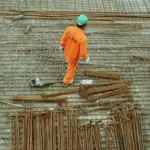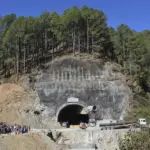Artificial Intelligence (AI) is playing a pivotal role in reshaping various industries, and the field of construction is no exception.
It brings forth a wave of advancements, offering benefits ranging from enhanced safety measures to increased operational efficiency.
- Many Problems – One Solution – AI
- How AI function?
- Safety Reinforcement
- Planning and Design Optimization
- Project Management Assistance
- Resource Efficiency Enhancement
- Quality Assurance
- Predictive Maintenance
- Autonomous Vehicles Integration
- Real-time Collaboration Tools
- Sustainability Enhancement
- Controlling Project Costs Effectively
- AI’s Role in Optimizing Building Design through Generative Design

Many Problems – One Solution – AI
AI is becoming a game-changer in the construction industry, offering value across various stages of a project’s life, from design and bidding to financing, procurement, construction, operations, asset management, and even business model transformation.
This technological advancement addresses some of the most pressing challenges faced by the industry, including safety concerns, labor shortages, and issues related to costs and schedules.
As the barriers to entry in the market decrease steadily and technologies like AI, machine learning (ML), and analytics make significant strides, the role of AI in construction is expected to grow substantially in the coming years.
The allocation of resources towards AI is set to become more prominent, shaping the future landscape of the construction sector.
How AI function?
Understanding how AI functions in construction involves delving into the realms of Artificial Intelligence and Machine Learning.
AI serves as an umbrella term for instances where machines replicate human cognitive functions, such as problem-solving, pattern recognition, and learning.
Machine Learning, a subset of AI, employs statistical techniques to enable computer systems to “learn” from data without explicit programming.
Like Us on Facebook!
The more data a machine is exposed to, the better it becomes at understanding and providing valuable insights.
Subscribe Us on YouTube!
In the construction context, the ML algorithms become far more intricate. For instance, a machine learning program might assess progress in a grading plan, factoring in cut and fill volume measurements, machine uptime and downtime, weather patterns, and data from previous projects to generate a risk score. This score helps in early identification of schedule risks and determines whether notifications are necessary.
The applications of machine learning and AI in construction are extensive. In the industry, dealing with a plethora of information such as requests for information, open issues, and change orders is standard.
Machine learning acts as a smart assistant, sifting through this massive amount of data and alerting project managers to critical matters that require attention. From basic tasks like filtering spam emails to advanced safety monitoring,
AI is transforming the construction landscape, making processes more efficient and informed.
Let’s delve into nine specific ways in which AI holds the promise of transforming the construction sector, making processes more streamlined and effective.
Safety Reinforcement
AI introduces a groundbreaking transformation in construction safety. Utilizing AI-powered sensors and cameras, job sites can be monitored in real-time. These technologies can identify potential hazards, such as inadequate safety equipment, improper tool usage, or malfunctioning equipment. By analyzing data from past projects, AI helps in recognizing patterns and predicting potential safety issues, allowing companies to proactively eliminate hazards in future endeavors.
Planning and Design Optimization
In the realm of planning and design, AI lends a helping hand by optimizing processes and prefabrication. Drawing insights from data collected in previous projects, AI identifies areas for cost reduction and efficiency improvement. This not only saves time and resources but also elevates the overall quality of construction projects.
Project Management Assistance
AI-powered project management tools contribute significantly by identifying potential delays or cost overruns. These tools assist construction companies in staying on track and within budget, offering solutions to minimize the impact of potential challenges throughout the project.
Resource Efficiency Enhancement
Construction companies benefit from AI’s ability to optimize resource usage, including materials and labor. By pinpointing areas where waste can be reduced or resources used more efficiently, AI contributes to improved resource management.
Quality Assurance
With real-time monitoring through AI-powered sensors and cameras, construction companies ensure that work adheres to the highest standards. This proactive approach helps prevent mistakes or defects, ensuring project completion to the satisfaction of clients and regulatory bodies.
Predictive Maintenance
AI’s predictive capabilities extend to maintenance schedules, anticipating when equipment is likely to fail. By scheduling maintenance before problems occur, construction companies minimize equipment downtime and maintenance costs, avoiding costly repairs and keeping projects on schedule.
Autonomous Vehicles Integration
AI-powered vehicles find application on construction sites for material and equipment transport. Besides reducing the need for human labor, these vehicles operate more efficiently, curbing fuel consumption and emissions, aligning with sustainability initiatives and improving overall safety.
Real-time Collaboration Tools
AI-enhanced collaboration tools facilitate improved communication among teams working on various project aspects. Real-time data sharing and analysis enable teams to make informed decisions collectively, enhancing overall project efficiency.
Sustainability Enhancement
AI plays a crucial role in improving sustainability efforts within construction businesses. Analyzing data on energy consumption, emissions, and other environmental factors, AI provides insights for reducing environmental impact and enhancing overall sustainability performance.
In conclusion, the integration of AI holds immense potential for revolutionizing the construction industry. By embracing AI-powered tools and technologies, construction companies pave the way for improved safety measures, increased operational efficiency, and elevated project quality, positioning themselves at the forefront of the competitive landscape.
Controlling Project Costs Effectively
In the realm of mega projects, cost overruns are a common challenge, even with top-notch project teams at the helm. Artificial Neural Networks emerge as valuable tools in foreseeing and preventing budget overruns.
These networks leverage diverse factors such as project size, contract type, and the proficiency of project managers to predict potential cost deviations. By tapping into historical data encompassing planned timelines, predictive models offer a glimpse into realistic schedules for forthcoming projects.
Moreover, AI facilitates remote access to practical training materials, enabling swift skill and knowledge enhancement for project staff. This streamlined onboarding process expedites project delivery by reducing the time it takes to integrate new resources.
| ID | Problems in Construction Industry | How AI can provide a solution? |
|---|---|---|
| 1 | Safety Concerns | AI-powered sensors and cameras monitor job sites in real-time, identifying hazards and analyzing data from past projects to predict safety issues. |
| 2 | Labor Shortages | AI and machine learning help construction firms analyze data for real-time labor and machinery distribution, addressing labor shortages and boosting productivity. |
| 3 | Cost and Schedule Overruns | AI aids in project management by identifying potential delays or cost overruns, offering solutions to minimize the impact of challenges throughout the project. |
| 4 | Resource Management | AI optimizes resource usage, pinpointing areas where waste can be reduced or resources used more efficiently, contributing to improved resource management. |
| 5 | Quality Assurance | Real-time monitoring through AI-powered sensors and cameras ensures work meets the highest standards, preventing mistakes and defects. |
| 6 | Predictive Maintenance | AI predicts equipment failures, enabling scheduled maintenance to minimize downtime and costs, avoiding costly repairs and keeping projects on schedule. |
| 7 | Autonomous Vehicles Integration | AI-powered vehicles on construction sites reduce the need for human labor, operate efficiently, and align with sustainability initiatives. |
| 8 | Real-time Collaboration Tools | AI-enhanced collaboration tools improve communication among project teams, enabling real-time data sharing and analysis for informed decision-making. |
| 9 | Sustainability Enhancement | AI analyzes data on energy consumption, emissions, and environmental factors, providing insights to improve sustainability performance. |
| 10 | Project Cost Control | Artificial Neural Networks predict and prevent cost overruns by considering factors such as project size, contract type, and project manager proficiency. |
| 11 | Building Design Optimization | AI-powered generative design identifies and mitigates clashes between models, optimizing the planning and design process in construction. |
| 12 | Overall Industry Transformation | AI reshapes the construction industry by addressing challenges, enhancing safety, improving efficiency, and elevating project quality. |
AI’s Role in Optimizing Building Design through Generative Design
The advent of Building Information Modeling (BIM) revolutionizes the construction process by providing a 3D model-based approach for efficient planning, designing, constructing, and managing buildings and infrastructure.
Crafting the construction plan and design involves integrating 3D models that encompass architectural, engineering, mechanical, electrical, and plumbing (MEP) plans, along with the sequential activities of diverse teams. The challenge lies in ensuring these diverse models align seamlessly, avoiding clashes.
Machine learning, in the form of AI-powered generative design, steps in to address this challenge. This technology identifies and mitigates clashes between models generated by different teams, aiming to prevent rework.
Specialized software utilizes machine learning algorithms to explore various solution variations, generating design alternatives.
Users input requirements into the model, and the generative design software crafts 3D models optimized for constraints, learning iteratively until it arrives at the ideal model. This innovative application of AI transforms the design process, promoting efficiency and minimizing conflicts in building projects.
The future belongs to AI
Revolutionary technologies such as Robotics, AI, and the Internet of Things are heralding a new era in construction, potentially slashing building costs by a substantial 20 percent. Imagine engineers donning virtual reality goggles, guiding mini-robots through structures under construction. These nimble robots, equipped with cameras, meticulously track and document the ongoing work. Moreover, AI is taking the reins in planning the intricate routing of electrical and plumbing systems within modern buildings. It’s not just about efficiency; companies are employing AI to pioneer safety systems for construction sites.
In the realm of safety, AI is stepping up by monitoring real-time interactions among workers, machinery, and various objects on construction sites. Its role extends beyond mere observation; AI acts as a vigilant guardian, promptly alerting supervisors to potential safety hazards, construction errors, and productivity concerns.
Contrary to fears of widespread job displacement, the integration of AI is not poised to replace the human workforce. Instead, it promises to reshape business models within the construction industry, curbing costly errors, mitigating worksite injuries, and enhancing overall operational efficiency.
For construction leaders, strategic investment in AI should be tailored to address the specific needs of their companies. Those who embrace these technologies early on will not only influence the industry’s trajectory but also reap the benefits in both the short and long term. The future of construction is evolving, with AI leading the charge towards a safer, more efficient, and technologically advanced landscape.















